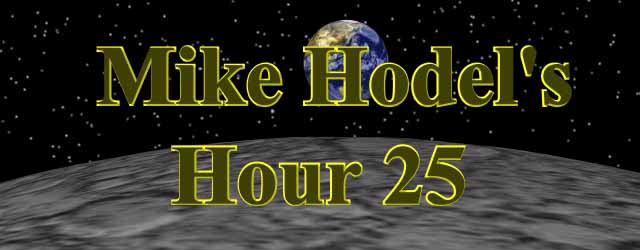| |
|
|
Index to our previous shows
Shows from April, 2002
Shows from March, 2002
February 24, 2002 - Tim Ziemba
February 8, 2002 - Terry Pratchett
Shows from January, 2002
Shows from December 2001
Shows from November, 2001
Shows from October, 2001
Shows from September, 2001
Shows from August, 2001
Shows from July, 2001
Shows from June, 2001
Shows from May, 2001
Shows from April, 2001
Shows from March, 2001
Shows from February, 2001
Shows from January, 2001
Shows from November - December, 2000
Shows from September - October, 2000
Shows from July - August, 2000
Tim Ziemba
On Sunday - February 24th, 2002 - we brought you an interview with Plasma Physicist Tim Ziemba talking about a very exciting new development in space technology. Tim is a graduate student at the University of Washington working with Dr. Robert Winglee to see if small artificially created magnetospheres can be used for spacecraft propulsion. If this technology proves practical, it will offer unprecedented capabilities for solar system exploration.
There is a plasma wind that blows through space and fills the solar system with the magnetically charged extended atmosphere of the sun. Although as tenuous as whisper from beyond the grave, this solar wind may prove to be the key to opening the solar system to exploration by humans and machines.
People have long speculated on using the radiation pressure of the light from the sun to propel spacecraft across the solar system. But this would require huge sails many miles across made from exceedingly light weight materials. A few years ago some people speculated about using magnetic sails created by large loops of superconducting material that would interact with the magnetic field of the solar wind and thereby propel spacecraft across the solar system. But this system would require spacecraft with structures tens or even hundreds of miles in diameter.
And then a couple of years ago Dr. Robert Winglee from the University of Washington at Seattle came up with the idea of creating artificial magnetospheres that would accomplish the same thing as solar or magnetic sails. This system is known as Mini-Magnetospheric Plasma Propulsion (M2P2).
|
|

From left, John Slough, Tim Ziemba, and Robert Winglee.
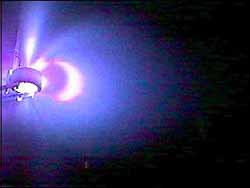
A test of the M2P2 unit showing the creation of a magnetic bubble in a test chamber.
|
These artificial magnetospheres would interact with the solar wind and use the force from that interaction to accelerate a spacecraft to tremendous velocities. But unlike solar or magnetic sails, these artificial magnetospheres could be created by small light-weight hardware.
The hardware required to propel a small spacecraft across the solar system would be the size of a two-drawer file cabinet and would require tiny amounts of working fluid and an electrical power system comparable to those used by the ComSats that orbit the Earth today. Such a spacecraft could accelerate to a velocity that would let it reach Saturn in six months, or it could even drive to a velocity of over 180,000 miles per hour. (80km/sec) At that speed it could overtake the Voyager 1 spacecraft in eight years and become the first human object to reach interstellar space.
Larger devices could be used to propel ships carrying human crews on voyages of exploration to the planets. And the magnetic field from the artificial magnetosphere might even prove strong enough to deflect the radiation that makes deep space voyages so dangerous. Using multiple drive units would allow the ship's magnetic field to be oriented so that the ship could 'tack' against the solar wind and be used to bring a spacecraft back from a voyage into deep space, not just for driving outward away from the sun.
This is one of the most promising and exciting space exploration technologies to come along in many a year. Much research and engineering development is needed before the first ship propelled by M2P2 sets sail for deep space, but this could be the tool that opens the solar system to human exploration.
Tonight's interview will introduce you to this technology. Prepare to get excited. I know I was after I did this interview.
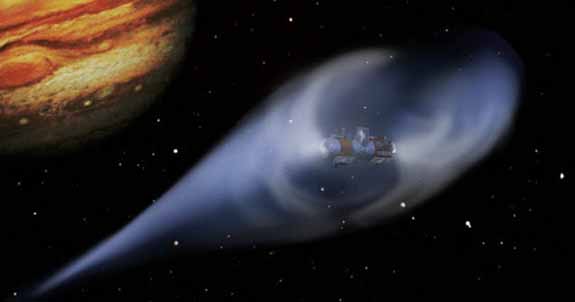
An artist's conception of an M2P2 powered spacecraft at Jupiter
Listen to this week's show
|
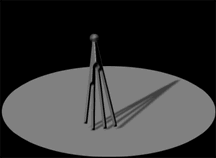
|
- Click here to listen to the entire show. {59:46}
or
- Click here for the show's intro music.{0:41}
- Click here for the show's opening. {14:32}
- Click here for the Tim Ziemba Interview. {42:45}
- Click here for the show's closing.{1:48}
or
- Click here for an index of all Shows on our site.
|
Links for more information relating to this week's show
M2P2 and Related Subjects
You can find out more about Mini-Magnetospheric Plasma Propulsion (M2P2) by checking out the project's
web site. {Be sure to view some of their movies of the test hardware in operation, along with animations showing various magnetospheric process. Note, these movies are rather long so they will require significant load times if you are not using a broadband connection.}
Additional information about M2P2 can be found in this University of Washington Press Release, this article from the UW College of Arts and Sciences Newsletter, at the NASA web site or in this article from News in Science.
Click here to visit a NASA web site discussing magnetospheres or here for a web site from Rice University discussing the Earth's plasma environment. This link will take you to a page discussing the simultaneous observations of the Aurora Borealis and Aurora Australis. Additional information about observing the Aurora Borealus can be found here.
You can get updates on the state of the Earth-Sun environment by going to the SpaceWeather.com web site or at the Space Weather Today web site.
And if you enjoyed this show and would like to know when other interviews are uploaded to the Hour 25 web site, then send an email to me at wwjames@earthlink.net and I will add your name to the free Hour 25 Newsletter mailing list. That way you'll get a brief notice in your email every time a new show gets uploaded to the web.
Space News
Click here to view the results of the NASA/Planetary Society survey about the future of planetary exploration. For more information about the Planetary Society and their work, click here
The SpaceRef.com web site has some very good reporting on both the new NASA budget and also on NASA's new rules for deciding who can go to the ISS. {Hint, people who criticize NASA should not be expecting to go to the ISS any time soon.}
Click here to view the on-line atlas of Mars. [Don't miss this, it is a treasure. With just a click of your mouse you can view Mars in a way that previous generations of astronomers could only dream of.}
Click here to listen to the song done by the pop group Blur for the Beagle 2 Mars Lander and view an animation of the landing. {Note, this link plays a Real audio format clip. You might want to follow this link when you are not listening to this week's show because doing the two at the same time may confuse you computer.} Click here for a story from the BBC about this tune and here for more information about the Beagle 2 Mars Lander.
ISS News
The Florida Today web site has a very interesting report about the causes of the ISS budget problems and their impact on the space program. It makes very interesting reading.
Click here to view the press kits for various ISS missions.
Check out the NASA International Space Station web page or the Boeing web page to learn more about this project.
A great source of news about Russian space activities, including their work on the ISS, can be found at the Russian Space Web.
Do you wonder where the Space Station is right now? You can use your browser to view real time maps showing the location of the ISS by going to this link at the NASA Space Link web site or here at the Johnson Spacecraft Center. Please note that your browser must support Java to make use of this satellite tracking software.
You can find out when the ISS - or many other spacecraft - can be seen from your location by going to this NASA web page. Please note; your browser must support Java for this application to work.
For On-Going Updates on Space News
The Space Today web site is a great place to find space news from all over the 'net.
The Spaceflight Now web site carries real time information about current space missions and presents a lot of space and astronomy news. This is the place I go to when I want up to the minute information about current space missions. Do I need to say more?
The NASA Watch web site is another great place for getting information about current space missions. Check there also for news about other 'goings on' within NASA. Highly recommended.
Click here for information about the audio files used for Hour 25 and for information about configuring your browser and downloading audio players.
Please note web pages from external sites will open in a separate browser window and that Hour 25 Productions are not responsible for the content of any external Web Sites.
|
Return to the Index for this month's shows
|
This Week - Terry Pratchett
On Friday - February 8th, 2002 - we brought you an interview with author Terry Pratchett.
In the 1980's Terry Pratchett started writting his Discworld books, which were intended as a satire of the fantasy genre. These books turned out to be incredibly popular and over time have morphed into satires on real life and anything else that Terry sets his sites upon. Although this is a long running series, each book is written so that people new to Discworld can follow the story. If you're looking for a good laugh, and don't mind having fun poked at many of the tropes of fantasy, then check out these books. You won't be disappointed.
It was great fun sitting down with Terry Pratchett for this interview, although as you will hear, he seemed to want to talk about anything and everything - other than his current books. {I did manage to get him onto that subject eventually, but we were having so much fun with everything else that it took a while to get there.}
I should note that we did this interview last fall, i.e. before the Lord of the Rings film had opened. It remains to be seen if our hopes, and fears, for this movie are ultimately justified.
|
|
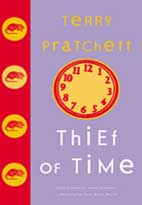
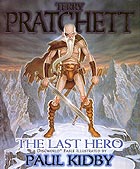 |
Listen to this week's show
|

|
- Click here to listen to the entire show. {1:37:04}
or
- Click here for the show's intro music.{0:41}
- Click here for the show's opening. {5:27}
- Click here for the Terry Pratchett Interview. {1:29:09}
- Click here for the show's closing.{1:47}
or
- Click here for an index of all Shows on our site.
|
SoCal Launch Alert
A Delta 2 will be launched from Vandenburg AFB sometime soon. This vehicle will be carrying a set of Iridium satellites and the launch time is being announced prior to the event, unlike most of the classified military launches from Vandenburg. The next launch opportunity may come as early as Sunday morning, February 10.
If you live in the Southern California area you should be able to see the rocket as it flies to orbit - weather permitting. This is a sight not to be missed. Two launch opportunities have already been scrubbed and the weather is not promising for the Sunday attempt. However, the launch should happen sometime soon. Updated information for this launch can be found at this web page at the Spaceflight Now web site. Check there for updated information concerning when this launch will happen.
A rocket flying into space is an inspiring sight to behold. Don't miss it.
The Hour 25 "Give Karen Willson a Five Word Challenge" Event
Karen Willson has offered to write an original song for Hour 25, but you folks will have to help out. Send in any five words and Karen will use them in a song. {"Naked Polynesian Island Slave Girls" has already been used, so think of something else.} The field is open so use your imagination. Send your five words to me at wwjames@earthlink.net. {If you think of more than one set of five words, that's OK. Send all of them to me.} Karen and I will pick the winning entry and it will be up to her to craft a song using those words. You can hear more about this event by listening to our interview with Karen. {Don't ask me how we'll pick the winner, cause I can't answer that question. But I'm sure we'll recognize the winning entry when we see it.} BTW, I will declare that for purposes of this event "Hour 25" is one word. And for the person who comes up with the entry that Karen uses for the song, I'll find something special and send it along to you as my way of thanking you for your part in this escapade. The timing for this event is rather open - you know how I am about time and deadlines - so this event will go on until the right five words come in. That might happen in a day or it might take a few weeks. So get busy, if you snooze, you lose. How hard can it be to think up five words?
Links for more information relating to this week's show
Terry Pratchett
You can find out more about Terry Pratchett and his discworld series by visiting his web site.
More information about Terry and his books can be found at this fan run web site.
Click here to go to the Discworld Fandom web site where you will learn more about the discworld series - obviously - and also find ways to join the community of people who enjoy these books.
And if you enjoyed this show and would like to know when other interviews are uploaded to the Hour 25 web site, then send an email to me at wwjames@earthlink.net and I will add your name to the free Hour 25 Newsletter mailing list. That way you'll get a brief notice in your email every time a new show gets uploaded to the web.
Space News
Click here to view the results of the NASA/Planetary Society survey about the future of planetary exploration. For more information about the Planetary Society and their work, click here
The SpaceRef.com web site has some very good reporting on both the new NASA budget and also on NASA's new rules for deciding who can go to the ISS. {Hint, people who criticize NASA should not be expecting to go to the ISS any time soon.}
Click here to view the on-line atlas of Mars. [Don't miss this, it is a treasure. With just a click of your mouse you can view Mars in a way that previous generations of astronomers could only dream of.}
Click here to listen to the song done by the pop group Blur for the Beagle 2 Mars Lander and view an animation of the landing. {Note, this link plays a Real audio format clip. You might want to follow this link when you are not listening to this week's show because doing the two at the same time may confuse you computer.} Click here for a story from the BBC about this tune and here for more information about the Beagle 2 Mars Lander.
ISS News
The Florida Today web site has a very interesting report about the causes of the ISS budget problems and their impact on the space program. It makes very interesting reading.
Click here to view the press kits for various ISS missions.
Check out the NASA International Space Station web page or the Boeing web page to learn more about this project.
A great source of news about Russian space activities, including their work on the ISS, can be found at the Russian Space Web.
Do you wonder where the Space Station is right now? You can use your browser to view real time maps showing the location of the ISS by going to this link at the NASA Space Link web site or here at the Johnson Spacecraft Center. Please note that your browser must support Java to make use of this satellite tracking software.
You can find out when the ISS - or many other spacecraft - can be seen from your location by going to this NASA web page. Please note; your browser must support Java for this application to work.
For On-Going Updates on Space News
The Space Today web site is a great place to find space news from all over the 'net.
The Spaceflight Now web site carries real time information about current space missions and presents a lot of space and astronomy news. This is the place I go to when I want up to the minute information about current space missions. Do I need to say more?
The NASA Watch web site is another great place for getting information about current space missions. Check there also for news about other 'goings on' within NASA. Highly recommended.
Click here for information about the audio files used for Hour 25 and for information about configuring your browser and downloading audio players.
Please note web pages from external sites will open in a separate browser window and that Hour 25 Productions are not responsible for the content of any external Web Sites.
|
Return to the Index for this month's shows
|
Back to Hour 25 Home Page
Unless otherwise noted the entire content of this web site is Copyright © Warren W. James, 2000-2002.
All rights reserved.
|
|
